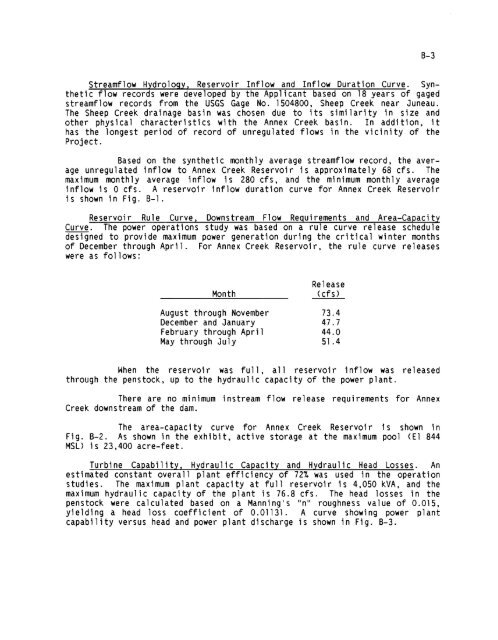- Page 1 and 2: Before the FEDERAL ENERGY REGULATOR
- Page 3 and 4: ANNEX CREEK/SALMON CREEK HYDROELECT
- Page 5 and 6: BEFORE THE FEDERAL ENERGY REGULATOR
- Page 7 and 8: . Alaska Public Utilities Commissio
- Page 9 and 10: EXHIBIT A PROJECT DESCRIPTION TABLE
- Page 11 and 12: A-2 AELP and, consequently, to AELP
- Page 13 and 14: Here a transition is made to a 78-i
- Page 15 and 16: Township Exhibit and Range Section
- Page 17 and 18: A-8 the crown of the arch, the dam
- Page 19 and 20: 3.6 ADDITIONAL EQUIPMENT A-10 Salmo
- Page 21 and 22: APPENDIX A-1 PROJECT LICENSE CHRONO
- Page 23 and 24: EXHIBIT B PROJECT OPERATION AND RES
- Page 25: 1.0 INTRODUCTION The Annex Creek an
- Page 29 and 30: 3.0 SALMON CREEK COMPONENT Sa 1 mon
- Page 31 and 32: B-7 Dur i ng adverse water years, w
- Page 33 and 34: B-9 3.3 PROJECT OUTPUT UTILIZATION
- Page 35 and 36: RESERVOIR SURFACE AREA (ACRES) 250
- Page 37 and 38: 240 220 200 180 -CI) 160 L&.. c.J -
- Page 39 and 40: 7~--------~------------------T-----
- Page 41 and 42: 1.0 CONSTRUCTION HISTORY OF EXISTIN
- Page 43 and 44: C-3 Date March 23, 1973 May 1977 Ev
- Page 45 and 46: C-5 1964-67 Date March 23, 1973 Dec
- Page 47 and 48: LIST OF TABLES Table Number D-1 D-2
- Page 49 and 50: D-2 2.0 FAIR VALUE, NET INVESTMENT,
- Page 51 and 52: 0-4 Table 0-6 presents the calculat
- Page 53 and 54: D-6 4.0 ESTIMATED ANNUAL VALUE OF P
- Page 55 and 56: TABLE D-2 ESTIMATED FAIR VALUE SALM
- Page 57 and 58: TABLE D-4 PROJECT ANNUAL COST ANNEX
- Page 59 and 60: ALTERNATIVE COST 10 MW DIESEL (1985
- Page 61 and 62: SEVERENCE DAMAGES (1985 DOLLARS) TA
- Page 63 and 64: TABLE D-7 AVERAGE ANNUAL PROJECT EN
- Page 65 and 66: TABLE D-8 Page 2 llL (2) (3) (4) (5
- Page 67 and 68: TABLE D-10 ANNUA~ 'IXED CHAftGaS PE
- Page 69 and 70: TABLE D-11 Page 2 Account lumber 19
- Page 71 and 72: APPENDIX 0-1 ALTERNATIVE FAIR VALUE
- Page 73 and 74: w , to :c x I,.lJ
- Page 75 and 76: TABLE OF CONTENTS (continued) Secti
- Page 77 and 78:
LIST OF TABLES Table Number E-2.1 E
- Page 79 and 80:
Appendix Number LIST OF APPENDICES
- Page 81 and 82:
E-2 o o Lower Powerhouse Transmissi
- Page 83 and 84:
E-4 1.2.3 Topography, Vegetation, a
- Page 85 and 86:
E-6 The dominant vegetative associa
- Page 87 and 88:
Creek. AELP has a water ri ght for
- Page 89 and 90:
E-10 Appropriation and adjudication
- Page 91 and 92:
2.2.3 Impacts of Continued Operatio
- Page 93 and 94:
_...-4 - - fi\LLg i> 2.2 WATER QUAL
- Page 95 and 96:
3.0 REPORT ON FISH, WILDLIFE, AND B
- Page 97 and 98:
E-15 15 m (50 ft.) wi de s pawi ng
- Page 99 and 100:
E-17 flow of 1.4 feet as recorded o
- Page 101 and 102:
TABLE E-3.1 Page 2 Length of Fish O
- Page 103 and 104:
TABLE E-3.2 Page 2 ~(2) (continued)
- Page 105 and 106:
E-19 the Project license was made 1
- Page 107 and 108:
E-21 other debris that would damage
- Page 109 and 110:
E-23 according to the Juneau Area R
- Page 111 and 112:
E-25 The Annex Creek Switchyard is
- Page 113 and 114:
E-27 north of the Lower Powerhouse
- Page 115 and 116:
Photo 1 Upper .~d Lower Annex Lake.
- Page 117 and 118:
Photo 5 Salmon Creek Dam Photo 6 Up
- Page 119 and 120:
E-29 7.0 LIST OF LITERATURE Alaska
- Page 121 and 122:
1 1 1 TRUE j/' NORTH ~29 . 5· MAGN
- Page 123 and 124:
- - -- ------------ - - ------, 1 T
- Page 125 and 126:
._ - --- _._- - - ------ ---- r TRU
- Page 127 and 128:
1. SCOPING PROCESS APPENDIX E-1 AGE
- Page 129 and 130:
o ~ ALAS&CA ELECTRIC LIGHT AND POWE
- Page 131 and 132:
ANNEX CREEK/SALMON CREEK HYDROELECT
- Page 133 and 134:
Mr. Robert W. McVey United States D
- Page 135 and 136:
ATTACHMENT C LICENSE ARTICLES PROTE
- Page 137 and 138:
~"~~IIIIIIIIIIIIIIIIIIIIIIII"1I1I1i
- Page 139 and 140:
. . !!I~[I;nlilfIUl!irilllfl!IJI!~l
- Page 141 and 142:
MEETING NOTES ANNEX CREEK/SALMON CR
- Page 143 and 144:
Page 3 Should an earthquake with a
- Page 145 and 146:
ALASKA ELECTRIC LIGHT AND POWER CO.
- Page 147 and 148:
ALASKA ELECTRIC LIGHT AND POWER CO.
- Page 149 and 150:
ALASKA ELECTRIC LIGHT AND POWER CO.
- Page 151 and 152:
ALASKA ELECTRIC LIGHT AND POWER CO.
- Page 153 and 154:
ALASKA ELECTRIC LIGHT AND POWER CO.
- Page 155 and 156:
ALASKA ELECTRIC LIGHT AND POWER CO.
- Page 157 and 158:
ALASKA ELECTRIC LIGHT AND POWER CO.
- Page 159 and 160:
ALASKA ELECTRIC LIGHT AND POWER CO.
- Page 161 and 162:
ALASKA ELECTRIC LIGHT AND POWER CO.
- Page 163 and 164:
ALASKA ELECTRIC LIGHT AND POWER CO.
- Page 165 and 166:
ALASKA ELECTRIC LIGHT AND POWER CO.
- Page 167 and 168:
ALASKA ELECTRIC LIGHT AND POWER CO.
- Page 169 and 170:
F·· L (~ a !; E~ c. C) n t a c. t
- Page 171 and 172:
BILL SHEFFIELD. GOVE.qNOR DEPART'IE
- Page 173 and 174:
BGH ENGINEERING, INC. 11550 CALUMET
- Page 175 and 176:
* (lTV/BOROUGH OF JUNEAU ALASI\AS C
- Page 177 and 178:
ALASKA ELECTRIC LIGHT AND POWER CO.
- Page 179 and 180:
The Salmon Creek c()mpon~nt lies wi
- Page 181 and 182:
Our corrnnents to the Federal Energ
- Page 183 and 184:
• # ·' STATE OF ALASKA DEPARTMEN
- Page 185 and 186:
ALASKA ELECTRIC LIGHT AND POWER COM
- Page 187 and 188:
~~~~[ @~ ~~~~~£ OF .. I£E OF THE
- Page 189 and 190:
Regulatory Branch .~~~l.1a~¢e Sect
- Page 191 and 192:
William A. Corbus 2 August 5, 1985
- Page 193 and 194:
Page E-ll: The text states that ana
- Page 195 and 196:
United States Department of the Int
- Page 197 and 198:
William A. Corbus -2- August 26, 19
- Page 199 and 200:
Changes in the natural state of wat
- Page 201 and 202:
, \.~. I OFFICE OF MANAGEMENT AND B
- Page 203 and 204:
• ~: United States ~ Department o
- Page 205 and 206:
2 significant facility development
- Page 207 and 208:
Cor1ifi~~;) l~o •.. ~.~.Q .......
- Page 209 and 210:
·..'::-:~.'.~.. ij ;~~'~': ~>I CER
- Page 211 and 212:
Changes in the natural state of wat
- Page 213 and 214:
. J.~~ ~V;;~." !. , I I CERTIFICA
- Page 215 and 216:
STATE·OF ALASKA DE~~TMENT OF NATUR
- Page 217 and 218:
FILE CUSTOMER-ID CASE STATUS LAS 19
- Page 219 and 220:
Changes in the natural state of wat
- Page 221 and 222:
CERTIFICATE OF APPROPRIATION ADL l0
- Page 223 and 224:
FILE ADL 100598 WATER RIGHTS INQUIR
- Page 225 and 226:
\. Water will be tuen from sl.lrfac
- Page 227 and 228:
M~g Addre~ ________________________
- Page 229 and 230:
APPENDIX E-3 WATER QUALTY STANDARDS
- Page 231 and 232:
ALASKA WATER STANDARDS S-$83 708:10
- Page 233 and 234:
ALASKA WATER STANDARDS S-583 708:10
- Page 235 and 236:
ALASKA WATER STANDARDS 8-650 706:10
- Page 237 and 238:
~lf~lf~ (OJ~ ~~~£[K\~ • DEPT. OF
- Page 239 and 240:
APPENDIX E-4 SALMON CREEK FLOW DATA
- Page 241 and 242:
140nth 1'fJ,11y 1")n1.1~ Daily 1911
- Page 243 and 244:
United States Department of the lnt
- Page 245 and 246:
APPENDIX E-5 RECREATION The Federal
- Page 247 and 248:
Project No. 2307 - 2 - In conjuncti
- Page 249 and 250:
Al·rEfIDHENr NO.3#, I g INSTRmt1El
- Page 251 and 252:
Project No. 2307 - 3 - Interior, al
- Page 253 and 254:
,".~. ,#",,:M' Project No. 2307 - 5
- Page 255 and 256:
APPENDIX E-6 LAND USE DESIGNATIONS
- Page 257 and 258:
APPENDIX E-7 VISUAL QUALITY OBJECTI
- Page 259 and 260:
Varie1y Classes Process Variety Cla
- Page 261 and 262:
3. Rate features for variety This o
- Page 263 and 264:
, Sensitivity Leve'ls Process Sensi
- Page 265 and 266:
Level 2 ____ tfilt ......,.iliF1lt.
- Page 267 and 268:
Map Preparation for Sensitivi1y Lev
- Page 269 and 270:
8. When the overlays developed in s
- Page 271 and 272:
Quality Objectives At this p.olnt I
- Page 273 and 274:
Retention R This visual quality obj
- Page 275 and 276:
Partial Retention PR Management act
- Page 277 and 278:
Modification M Under the modificati
- Page 279 and 280:
Maximum Modification, MM Management
- Page 281 and 282:
Unacceptable M,odification This sec
- Page 283 and 284:
Rehabilitation reh Landscape rehabi
- Page 285 and 286:
APPENDIX E-8 ZONING DISTRICT DEFINI
- Page 287 and 288:
C-l. NEIGHBORHOOD COMMERCIAL DISTRI
- Page 289 and 290:
COASTAL PROJECT QUESTIONNAIRE 9/lfH
- Page 291 and 292:
c. Timber Yes No X If yes, amount?
- Page 293 and 294:
d) Incinerator burning more than 10
- Page 295 and 296:
· . utilization at the Power Plant
- Page 297 and 298:
APPENDIX E-10 STREAM GAUGE SALMON C
- Page 299 and 300:
,. Alaska· light and Power Company
- Page 301 and 302:
TRUE NORTH 729.5- -MAGNETIC NORTH I
- Page 303 and 304:
1 20'-0· ,------ --- -------------
- Page 305 and 306:
1 1 'b "' !!! 24· 010. tingle oate
- Page 307 and 308:
I 200 I 800 1 r--------------------
- Page 309 and 310:
I I 1 I ,. 1 . -'----~- Trashrack~
- Page 311 and 312:
TRUE NORTH MAGNETIC NORTH /IIPPER P
- Page 313 and 314:
EXHIBIT G PROJECT AREA MAPS TABLE O
- Page 315 and 316:
POWER CONDUIT ALIGNMENT EXHIBIT G-2
- Page 317 and 318:
COURSE NO FROM TO o (Lower PH I I 2

















